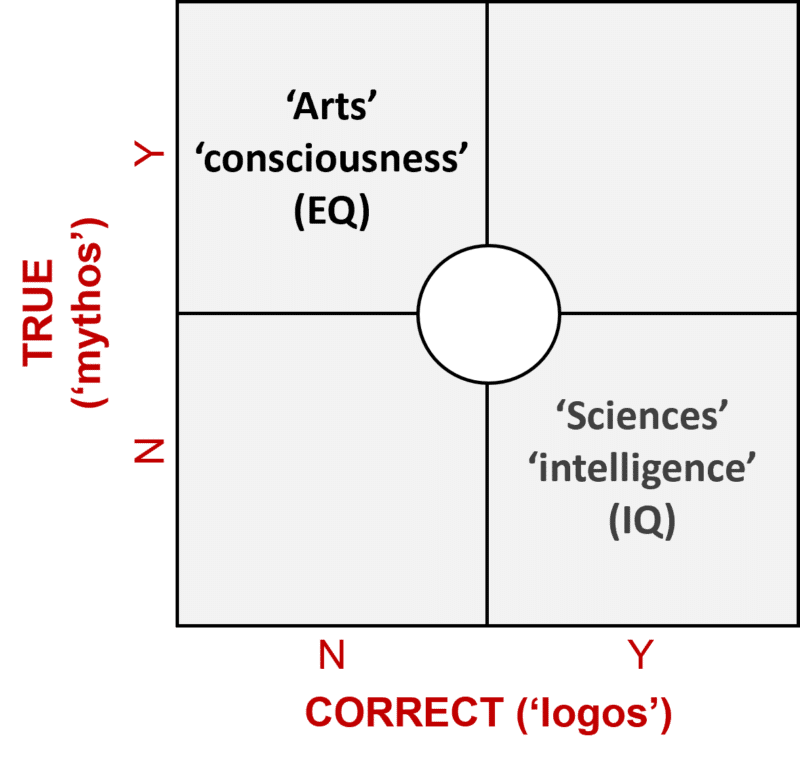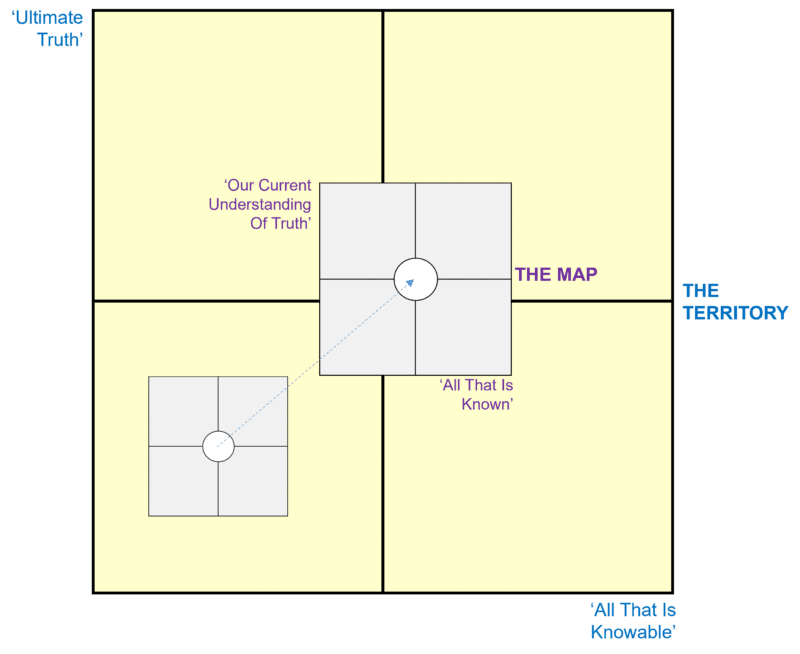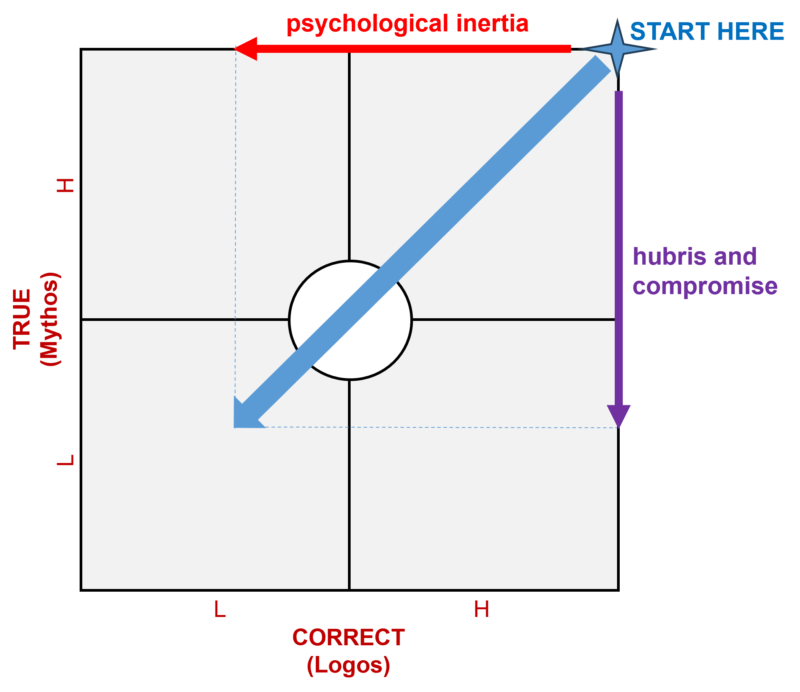Facts are simple and facts are straight
Facts are lazy and facts are late
Facts all come with points of view
Facts don’t do what I want them to
Facts just twist the truth around
Facts are living turned inside out
Facts are getting the best of them
Facts are nothing on the face of things
Talking Heads, Crosseyed & Painless
I realise a lot of people have an aversion to 2×2 matrices. Usually, I find, because they’ve nearly always seen them as categorisation tools, rather than what I think is their actual purpose. Or purposes. The first of which is that the best ones help us to identify contradictions. The second is that they’re much more useful when viewed as a kind of map. One in which we work out where we are, where we’d like to be and then start thinking about how we can get from one position to the other. The third – more subtle – purpose is when they force us to think about the dynamic nature of the world.
One of the 2×2’s that has had a big impact on how we conduct both our innovation and troubleshooting work is the True/Correct Landscape I first felt brave enough to talk about just over five years ago (https://www.darrellmann.com/yes-that-is-correct-but-is-it-true/). The realisation that provable, fact-based, ‘correct’ reality is not the same as ‘truth’ still takes a little while for people to get their heads around. Now comes the perhaps equally jarring realisation that both dimensions are also dynamic.
Here’s the original matrix:

Now let’s try a couple of thought experiments with it.
The first involves thinking about it as a map. In which case we need to become aware that this map is not the territory. The territory in this case, if we focus on the top right hand corner, ought to be defined by ‘all that is (factually) knowable’ in the x-axis direction, and ‘Ultimate Truth’ in the y-axis. These two axes define the yellow shaded territory in this image:

The True/Correct Landscape – ‘the map’ – then sits on top of this yellow territory. We might think of this grey area as mankind’s current understanding of knowledge and truth. The top right-hand corner of this area then in effect represents ‘all that is currently known’ in the x-axis direction, and ‘our current understanding of truth’ in the y-direction. Finally, we might imagine how, as our collective understanding of the world increases over time, the position of the grey area will both shift upwards and rightwards, and also increase in size. The grey area, in other words, is like a moving satellite, floating over the territory.
Now let’s try a second thought experiment. This time one where we zoom in and think about a more detailed and specific situation where a person might find the True/Correct Landscape useful. Think about an entrepreneur conceptualising a new enterprise, for example, or someone thinking about setting up a new charity organisation, or someone planning a new religion, political party, or maybe even a new educational institution.
During this person’s initial thinking, a smart move would be to think about where they would like to position themselves on the Landscape. Even smarter would be to aim for the top right-hand corner. In which case they would gather together the best of the globally available – known – factual knowledge, and they would define a mission and vision that was consistent with our best interpretation of ‘truth’. The institution should ‘do no harm’ for example, or encompass ideas around ‘always doing the right thing’, writing a code of ethics, determining to treat employees as fully-functioning adults wanting to do meaningful work, or, if we really wish to push the limits, to respect and assure sanctity of life.
We thus build the institution on as solid (and ‘futureproof’) a foundation as possible: we’re going to do the right things for the right reasons.
Then we start. It is now time to get our heads down and get on with the job of turning the idea into the reality. We find people to join us on the mission, and we form a huddle to work through all the gory details of who our customers are going to be, what they want from us, when and where they want it, and how much money they’re prepared to pay for the benefits we’re going to give them. As soon as possible, we’ll test the model, no doubt learn that many of our hypotheses were wrong, and that we therefore need to pivot to a Plan B. And then probably Plans C through W, until eventually, if we’re persistent enough, and and we earn enough money to keep going through all the scary going-backwards times, we become successful. Customers love us. Investors love us. We have ‘made it’. We grow market share. We become the dominant player. We have lots of spare revenue that allows us to re-invest and ‘stay ahead’ of competitors. Life is good.
Which usually then means that life is about to become less good. For two main reasons.
The first is that the institution begins to become much more insular. We develop psychological inertia. We focus on our solutions and our knowledge and forget that the rest of the world is also busy generating new knowledge, recognising that customer needs are changing and hence conceiving and developing new solutions. One day a disruptive threat arrives into our nice, comfortable market. We laugh at it, sure in the knowledge that it will never displace our great products and services. Our knowledge is expanding, but the rest of the world’s is expanding faster, and hence, in terms of the True/Correct Landscape, relatively speaking we’re heading backwards, away from the top right corner we started.
Even worse (usually), the success of our institution also leads to hubris, and a growing belief that our mission an vision in someway represent not just our ‘right way’, but everyone else’s too.
Even worse than that, the larger the institution becomes and the more customers we serve, the more we begin to encounter things that don’t fit our initially defined principles and values. Some customers become more valuable than others. Then we allow ourselves to think its okay to sacrifice one or two ‘outliers’ for the sake of the majority. Then, when it starts to become more challenging to meet the quarterly projections, comes a realisation that some customers are more valuable than others. Some lives are more sanctious than others. Then the slippery slope begins to get more steeply downwards pointing. Sanctity of life, except for those people over there. Sanctity of life, except our enemies. Sanctity of life, but its okay to kill enemies in order to preserve those on ‘our side’. And so on. The point being that ‘our truth’ becomes precisely that: a truth that shifts further and further away from what the rest of the world would recognise as the truth. Our hubris and increasing willingness to compromise our ideals drops us faster and faster down from the top right-hand corner of the Landscape, until one day we wake up and realise we’re no longer even in the top right hand quadrant. The world has moved on and therefore, in relative terms, we’ve gone backwards. We were once the lauded pioneers. Now we’ve become the protestor-surrounded evil empire.

Just a thought experiment. Or two.
Or maybe a reminder that the three biggest issues preventing an institution from being FutureProof are psychological inertia, hubris and (moral) compromise.
